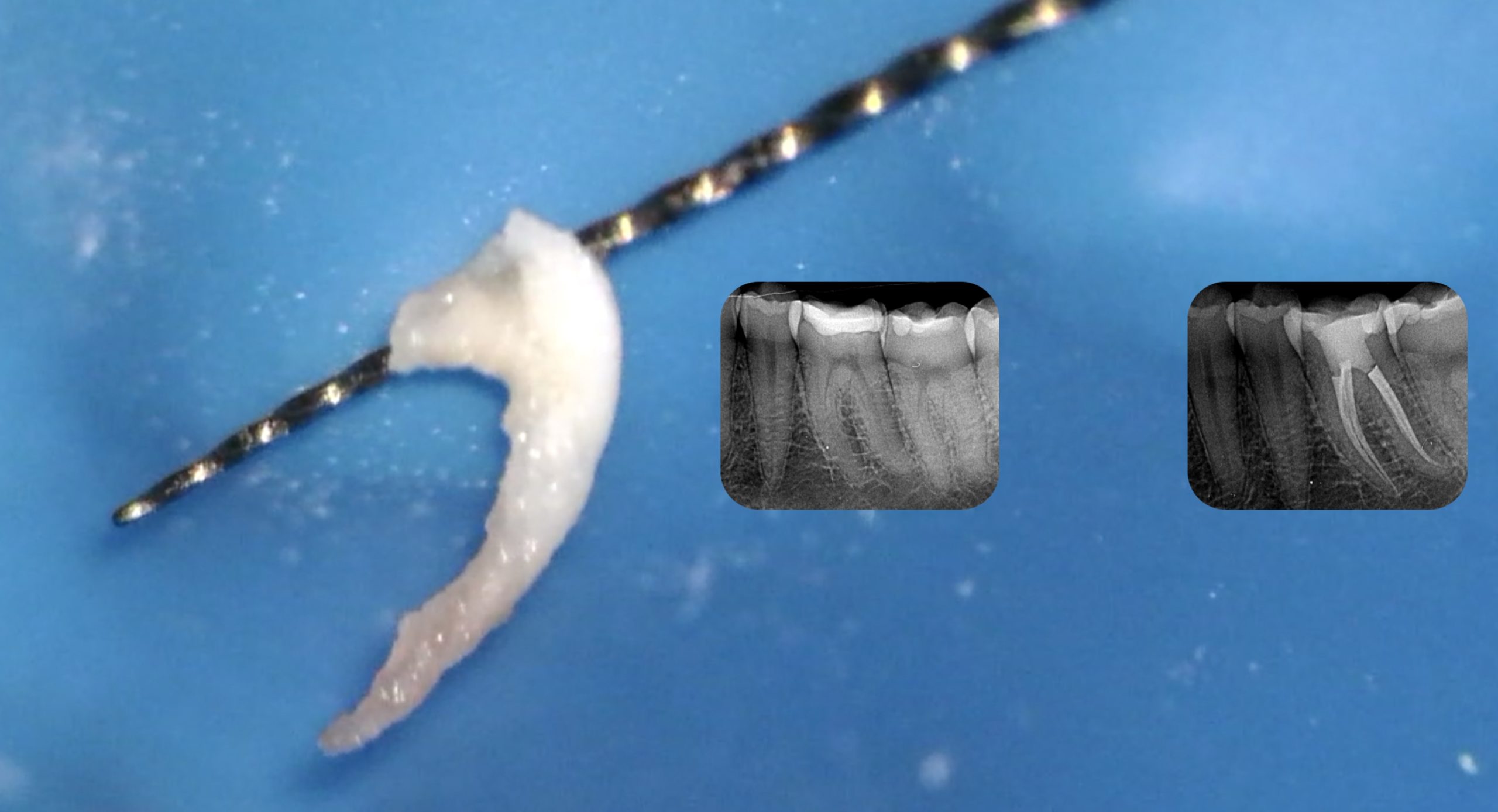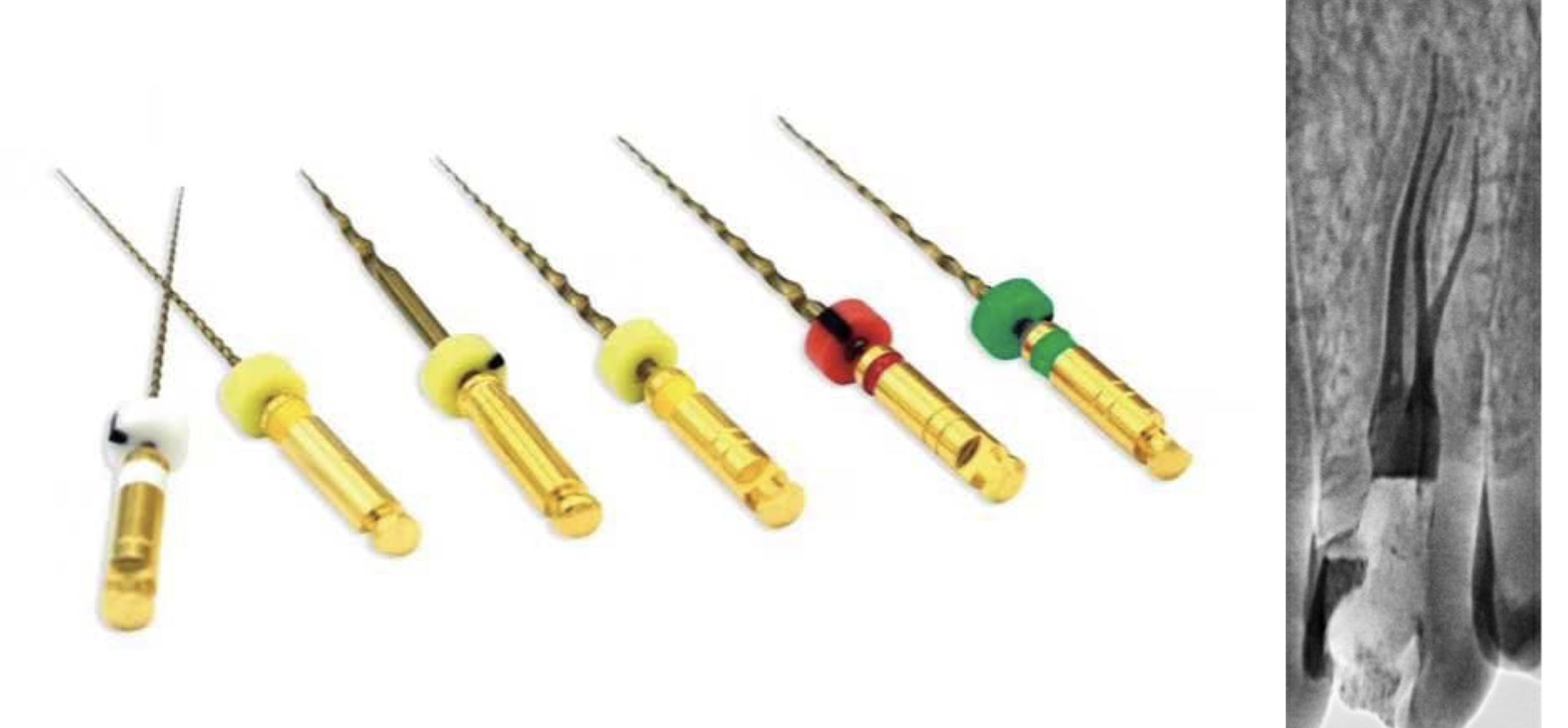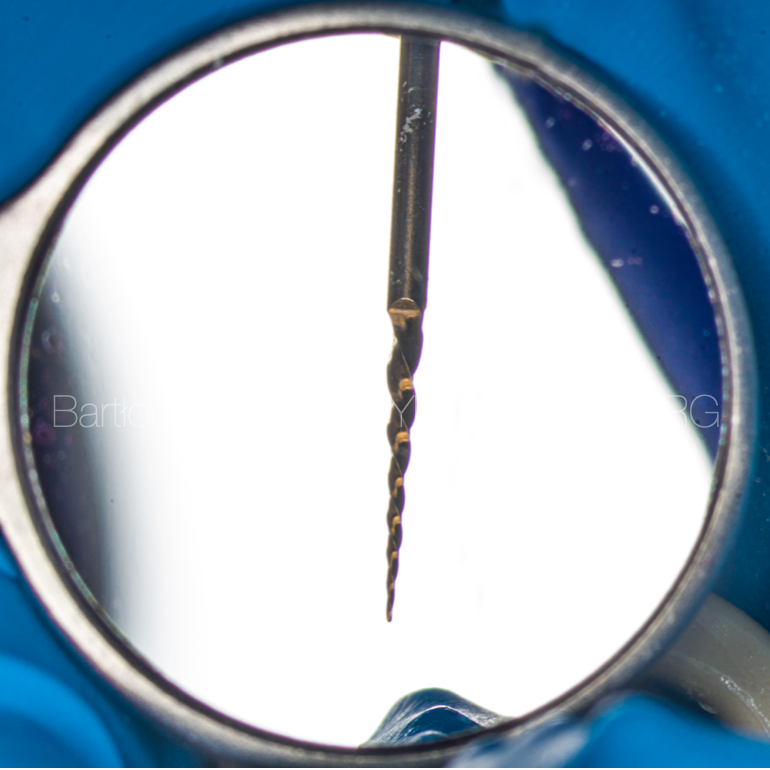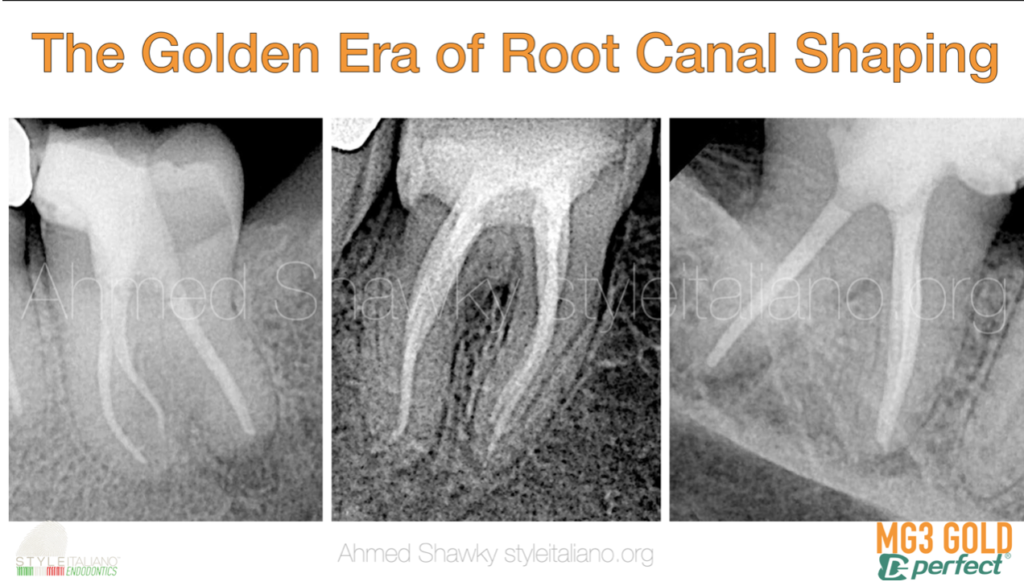
The Golden Era of root canal shaping
27/03/2022
Ahmed Shawky
Warning: Undefined variable $post in /var/www/vhosts/styleitaliano-endodontics.org/endodontics.styleitaliano.org/wp-content/plugins/oxygen/component-framework/components/classes/code-block.class.php(133) : eval()'d code on line 2
Warning: Attempt to read property "ID" on null in /var/www/vhosts/styleitaliano-endodontics.org/endodontics.styleitaliano.org/wp-content/plugins/oxygen/component-framework/components/classes/code-block.class.php(133) : eval()'d code on line 2
Following the access preparation and location of anatomy, the next challenge facing the endodontic clinician is to select the proper alloy and sequence for the shaping procedures in order to be able to safely and predictably shape the anatomy without any procedural errors.
This article will show the advantages of the MG3 Gold instruments and how can we customize the sequence of these files according the encountered anatomy and case difficulty for predictable root canal shaping with a high safety margin.
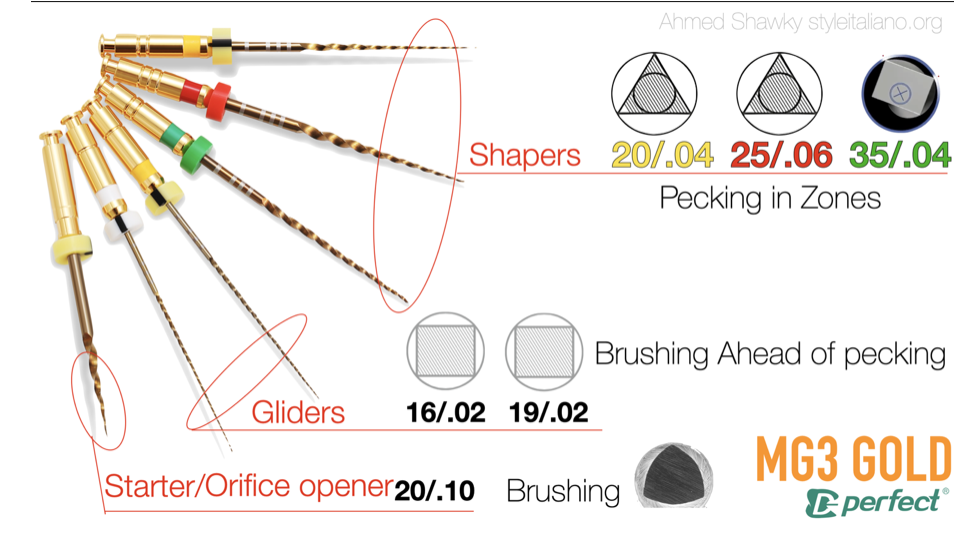
Fig. 1
First we will go through the components of the basic assortment of the MG3 Gold file system.
The main advantage of this file sytem is the presence of different designs and cross section in the same instrument kit, a smart thing for dealing with different anatomies.
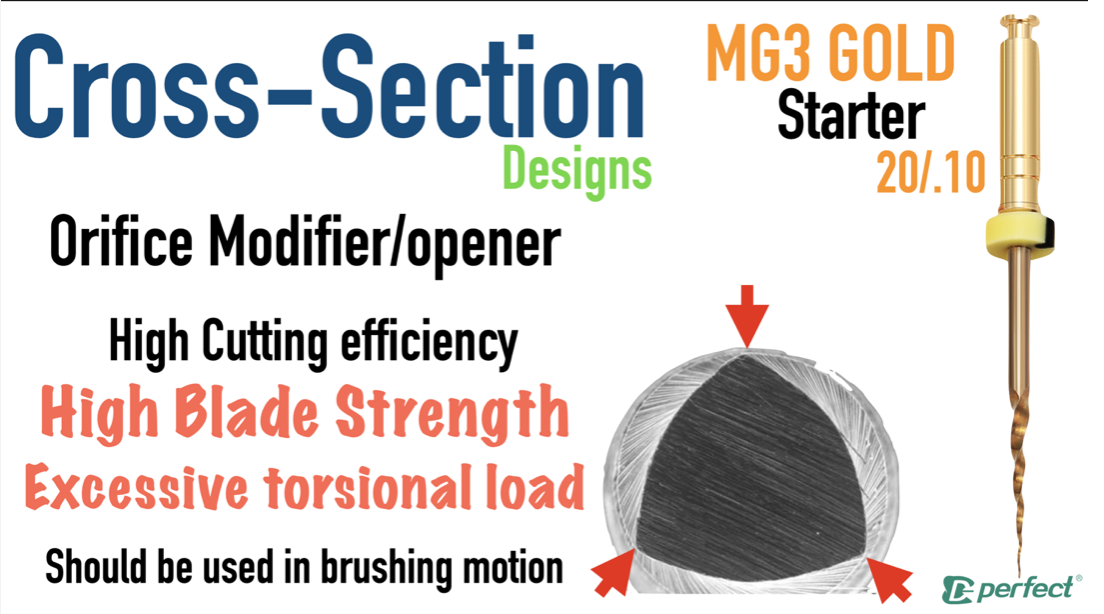
Fig. 2
Starter file (orifice modifier) [20.10]:
This file has a short working segment (9mm) and 19mm overall length. This would improve the accessibility in restricted areas.
It is used for mechanical Preflaring/orifice modification for elimination of coronal dentin resistance.
It has a convex triangular cross section which increases the blade strength, giving the instrument a high cutting efficiency.
With this cross section, the instrument would be subjected to excessive torsional load, therefore this instrument must be used in a brushing motion “towards the outer walls” and not pecking motion
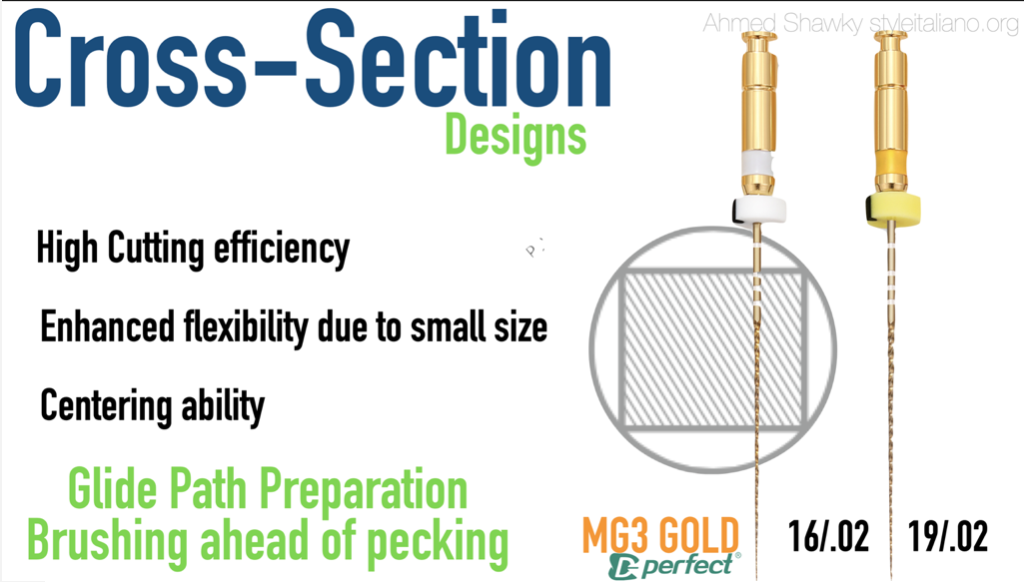
Fig. 3
The Gliders (16/.02 and 19/.02)
Another advantage in this system is having two glide path files. They can be used sequentially or not depending on the case difficulty. Sometimes we can use only one.
The rectangular cross section provides four blades for better centering ability (avoiding transportation) and in the same time having high cutting efficiency for reproducible glide path preparation.
The small size and taper of these files make them extremely flexible to negotiate mechanically difficult curvatures.
Due to the small size of the gliders, it is recommended to use them with “Brushing ahead of pecking” motion to avoid torsional failures
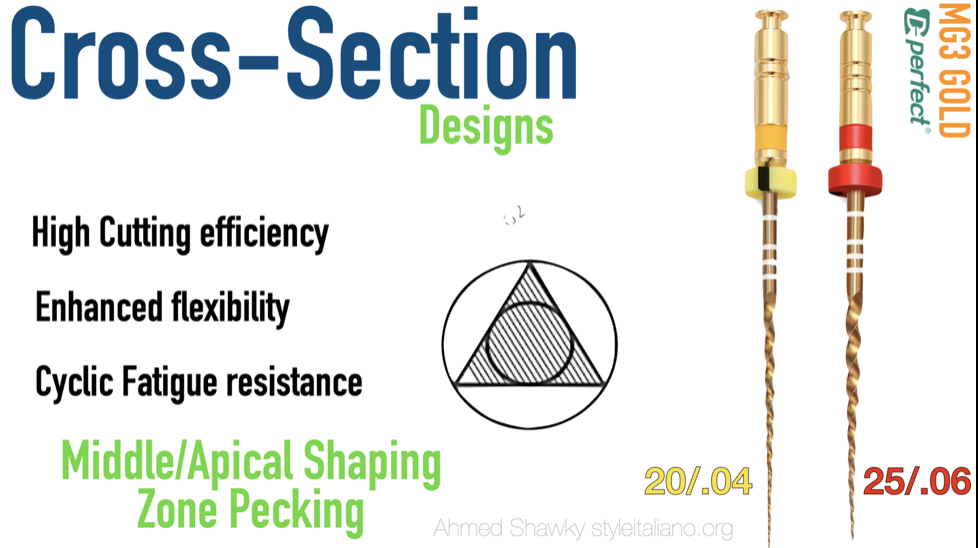
Fig. 4
The Shaping files [20/.04 and 25/.06]:
The cross section of the shaping files is traingular
This cross sectional design provides sharp blades for enhanced cutting efficiency and in the same time reduces the metal core of the instrument as the size is increased to maintain flexibility.
The Gold heat treatment provides a wear resistant surface with superior cutting behavior while enhancing the cyclic fatigue resistance.
The 25/4% file can be used in body shaping and can be used as a finishing file in cases with anatomical limitations such as severely curved canals.
The 25/6% file can be used for Pressurless preflaring as well as a shaping/finishing file.
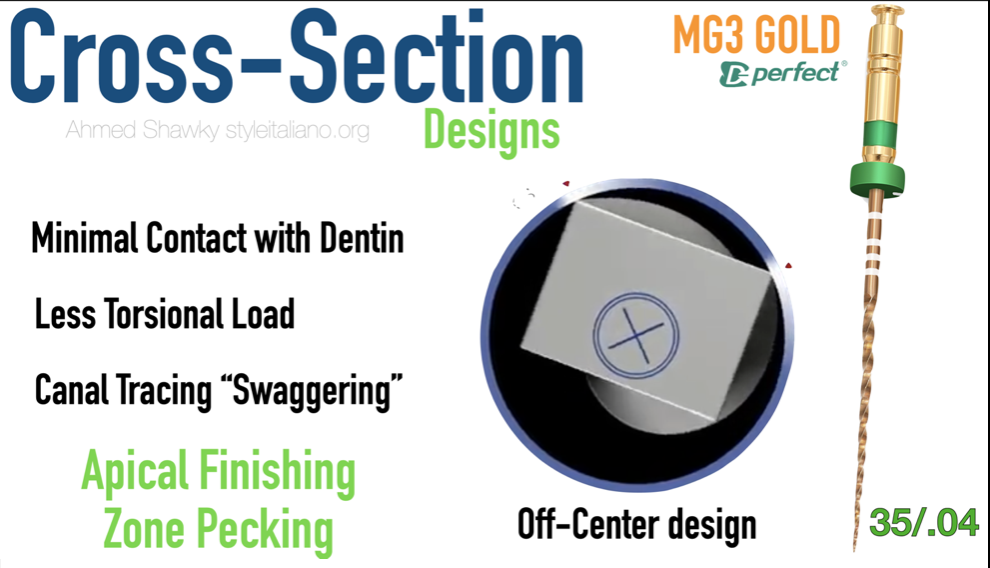
Fig. 5
The Shaping file [35/.04]]:
The cross section of the shaping files is off-center rectangular. This cross sectional design provides sharp blades for enhanced cutting efficiency and in the same time reduces the contact points of the instrument with the root canal walls. This would reduce the torsional load on this larger size and provides better clearance of debris.
The off-center design also make the instrument moves in a swaggering motion, for better canal tracing and avoiding transportations.
The 35/4% file is an optional file for increasing the preparation size in large root canals. It is used in zone pecking maneuvers.
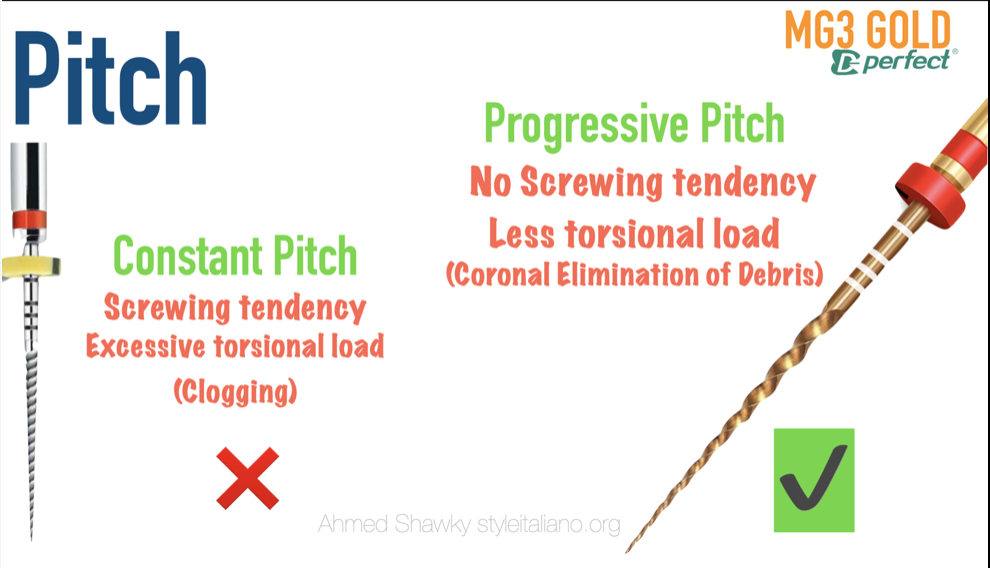
Fig. 6
Other MG3 Gold design features: The MG3 Gold files are machined with variable Pitch and helix allowing;
- Efficient coronal evacuation of debris.
- Absence of screw-in tendency
This would also reduce the torsional load on the instrument that would otherwise occur due to debris accumulation or excessive friction with the root canal walls.
Additional Information:
- non-assorted refills of all sizes are available for the clinician to customize his own treatment sequence up to ISO tip size #50
- All files are available in lengths of 21, 25 and 31 mm (Except the starter file, having 19 mm overall length)
- The recommended operation speed: 300-350 rpm
- The recommended torque: 2 (for the glide path and shaping files) And 3 N/cm (for the starter)
- Taper markings are present (1 mark for 2%, 2 marks for 4% and 3 marks for 6%)
- Precisely calibrated working length markings are engraved on the each instrument shank at 18, 19, 20 and 22 mm for easy reproduction of the recorded working lengths in each canal, especially in multi—rooted teeth having different lengths
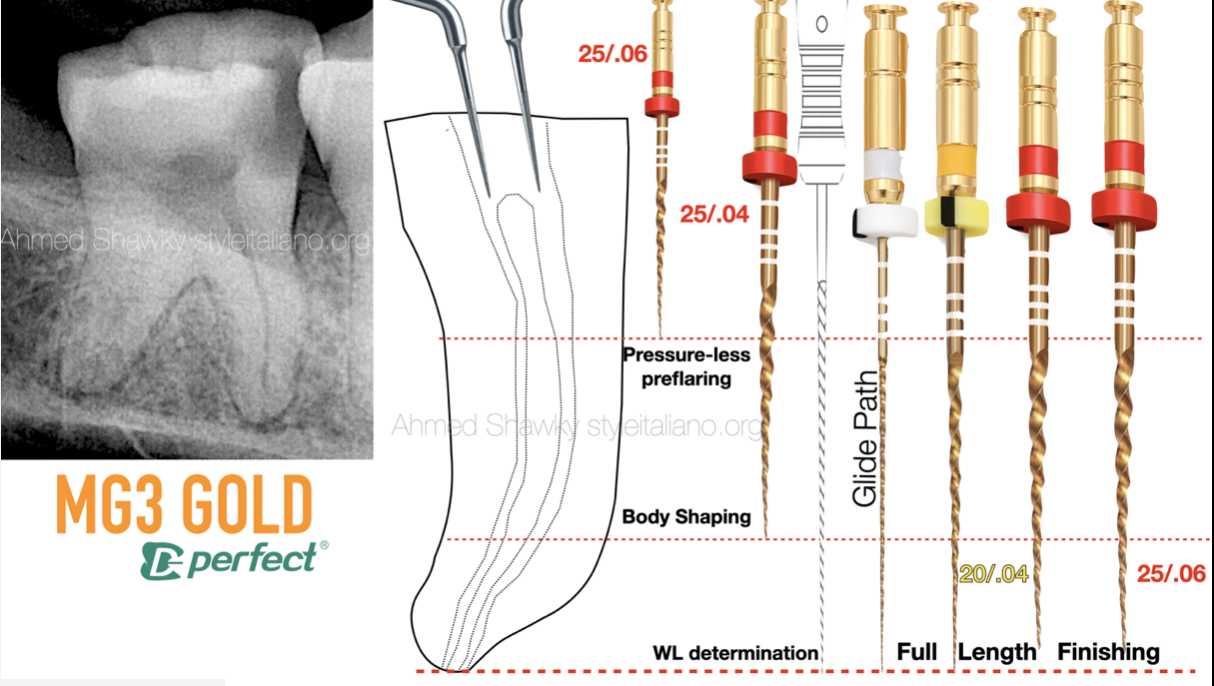
Fig. 7
Now lets see how can we use the MG3 Gold instruments;
A Mandibular third molar:
A patient presented to the clinic and diagnosed with symptomatic irreversible pulpitis with apical periodontitis.
After access preparation, only one mesial large orifice was identified.
Ultrasonic modification revealed the presence of 2 mesial canals originating from a single mesial orifice (sub-pulpal bifurcation)
Mechanical Preflaring with 25/06 MG3 GOLD followed by 25/04 mechanical body shaping allowed smooth glide path down the two separate mesial canals despite coronal restriction.
Following the reproducible glide path, shaping with 20/04, 25/04 and 25/06 was not a difficult job [VIDEO]

Fig. 8
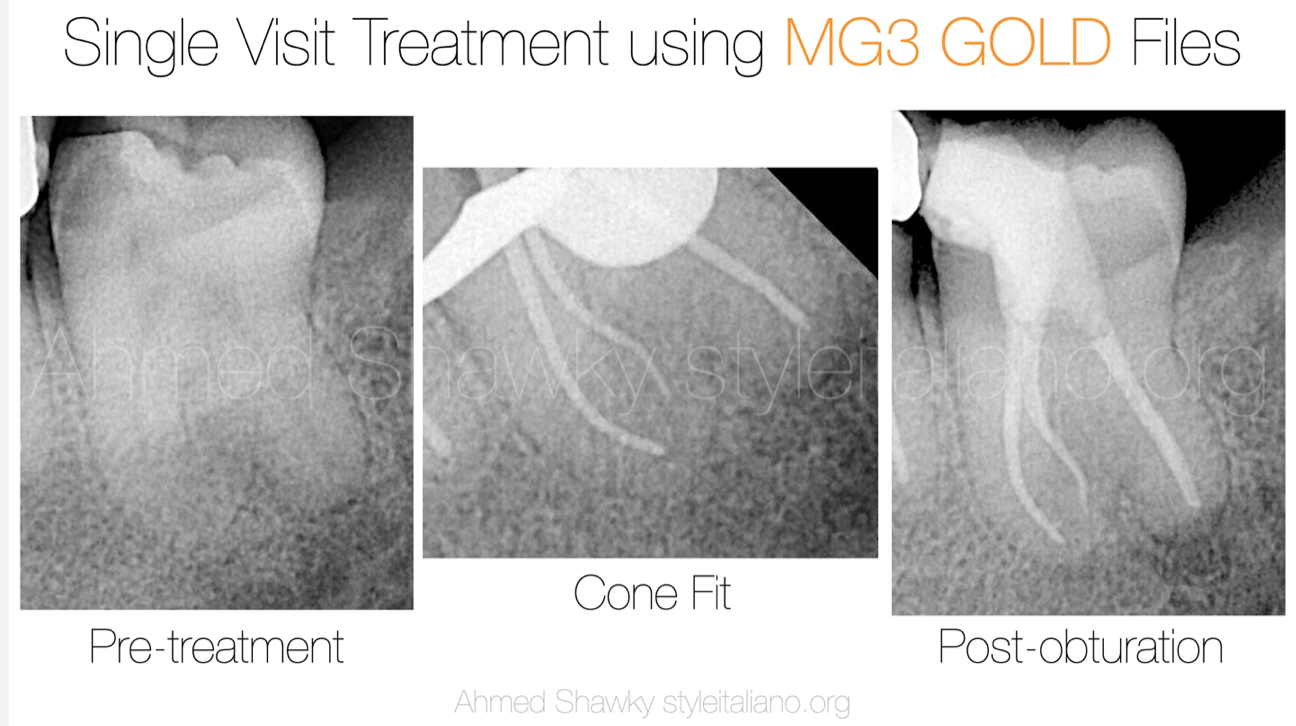
Fig. 9
Another Mandibular third molar:
A mandibular Third molar diagnosed with irreversible pulpitis and symptomatic apical periodontitis, was referred to my practice.. Using ultrasonic and high magnification, the canal entrances were negotiated usingMedium power ultrasonics and D-perfect C-Files.
A special concern was given to the coronal portion of the root canal, Especially to the mesiobuccal canal, due to the scouted double curvatures. Pressure-less Mechanical pre-flaring was done to reduce the coronal interferences (cervical dentin triangle-red triangle), which can impose huge stresses on the shaping files leading to a lot of procedural errors such as, instrument separation, transportation thereby increasing the difficulty of an initially straight-forward case.
mechanical pre-flaring in such a case can be either done using the starter/orifice modifier file (20/.10) or using the apical 3-4 mm of the 25/.06 shaping file or even both. The mode of action of these files is brushing motion towards the outer walls.

Fig. 10
A mandibular First Molar with Advanced Symptomatic pulpitis with apical periodontitis
Taking into consideration the constricted appearance of the root canals on the digital radiograph,MG3 Gold was the best suited for the situation due to the high cutting efficiency.
Mechanical preflaring with 25/.06 was done to faciltate body shaping using 25/.04 and a secured mechanical glide path to a final size of 30/.04 in a five canaled mandibular molar.
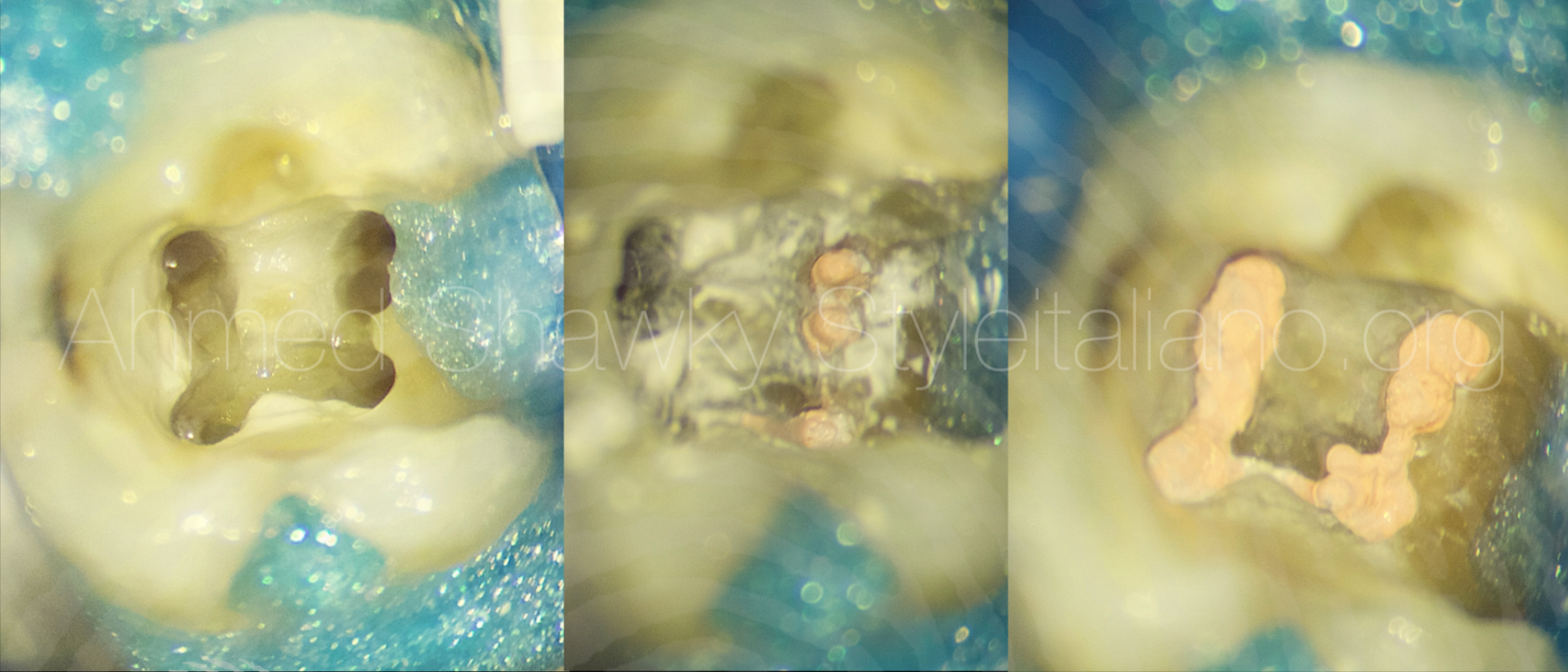
Fig. 11
Conclusions
Conclusions:
When dealing with Anatomy, variability is the rule. This is the reason that the endodontic practitioner must be able to modify the sequence of the instruments and treatment approach according to anatomy
The introduction of New files like MG3 Gold with low shape memory and high cutting efficiency allows the clinician to manage different cases with an excellent margin of safety and predictability
Bibliography
References:
- Schilder H. Cleaning and shaping the root canal. Dent Clin North Am. 1974; 18: 269-296
- Schilder H. Filling root canals in three dimensions. Dent Clin North Am. 1967; : 723-744
- Swati Srivastava, Current Strategies in Metallurgical Advances of Rotary NiTi Instruments: A Review J Dent Health Oral Disord Ther 2018, 9(1): 00333
- Gao Y, Gutmann JL, Wilkinson K, Maxwell R, Ammon D (2012) Evaluation of the impact of raw materials on the fatigue and mechanical properties of ProFile Vortex rotary instruments 10.1016/j.joen.2011.11.004
- Shen Y, Qian W, Abtin H, Gao Y, Haapasalo M (2011) Fatigue testing of controlled memory wire nickel-titanium rotary instruments J Endod 2011 Jul;37(7):997-1001. doi: 10.1016/j.joen.2011.03.023.
- Shen Y, Qian W, Abtin H, Gao Y, Haapasalo M (2012) Effect of Environment on Fatigue Failure of Controlled Memory Wire Nickel-Titanium Rotary Instruments https://doi.org/10.1016/j.joen.2011.12.002
- Shen Y, Zhou HM, Zheng YF, Peng B, Haapasalo M. Current challenges and concepts of the thermomechanical treatment of nickel-titanium instruments. J Endod. 2013 Feb;39(2):163-72. doi: 10.1016/j.joen.2012.11.005. PMID: 23321225.
- Peters OA, Gluskin AK, Weiss RA, Han JT. An in vitro assessment of the physical properties of novel Hyflex nickel-titanium rotary instruments. Int Endod J. 2012 Nov;45(11):1027-34. doi: 10.1111/j.1365-2591.2012.02067.x. Epub 2012 May 8. PMID: 22563821.
- Bartłomiej Karaś Hybrid shaping concept with MG3 rotary system. https://endodontics.styleitaliano.org/hybrid-shaping-concept-with-mg3-rotary-system/
- Ahmed Shawky The Blue Power: Safe and Predictable shaping using MG3 Blue.https://endodontics.styleitaliano.org/the-blue-power-safe-and-predictable-shaping-using-mg3-blue/



